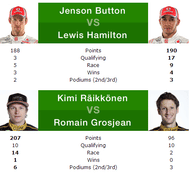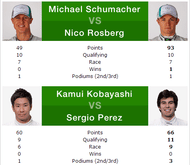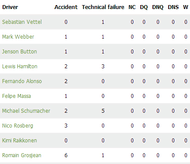The dust has fallen down on the 2012 F1 Season and so let’s take a insight into how various teams and drivers performed through out the year.
TeamMate Comparison:
Red-Bull and Ferrari:
From the figures it is quite clear that Alonso and Vettel had the upper hand compared to their respective teammates, but there were some notable changes within these two teams which are worth mentioning. First of all, Mark Webber had an upper hand midway through the season and his performances closely matched the performance of his younger teammate Sebastian Vettel, but after the summer break Webber’s performances were hugely disappointing even though Red-Bull had the fastest car then. Vettel on the other hand upped his game and won three back to back races from Singapore to India, which in my view sealed the World Championship for him.
At Ferrari, things took a different turn after the summer break as it seemed Felipe Massa was always slightly quicker than his much more experienced team mate Fernando Alonso and there were several races were Massa had to sacrifice positions for Alonso. All in all, Felipe Massa seems to have regained his pre-2009 form and is likely to come back even stronger in 2013. The Ferrari car, though not the fastest, showed great reliability and neither driver faced gearbox or engine problems throughout the season. The turning point for Ferrari was the two retirements Alonso incurred due to the two Lotus cars in Spa and Suzuka. Had that not happened, the championship story could have been different.
McLaren and Lotus:
At McLaren, Lewis Hamilton had the upper hand on his compatriot Jenson Button throughout the season. Jenson never really got the performance out of his McLaren during the qualifying sessions, and in many races had to come up through the field from lower grid positions. Hamilton on the other hand extracted the maximum performance out of his McLaren but was let down on many occasions by the poor reliability of his car. All in all, McLaren did have the package to challenge for the championship, but some big blunders, especially in pit stops and reliability, cost them essential points.
At Lotus, it was a one sided story as the returning Finn Kimi Raikkonen proved to be one of the most consistent drivers throughout the season, and, most importantly, got the elusive win for the guys at Enstone after a drought of four years. Romain Grosjean proved to be very quick but fragile and often got entangled in the first lap mayhem.
The Lotus E20, like Ferrari, proved to be one of the most reliable cars and they suffered only one technical failure which may have robbed Romain Grosjean of his first win in Valencia. Apart from Red-Bull, Lotus were the most consistent performers and their car showed consistent performance throughout the season, in any environment or track condition.
Mercedes and Sauber:
Mercedes started off the season on a strong note and at times looked to be challenging for victory, but their performances worsened as the season progressed and the second half of the season saw them being in the points on only two occasions.
As far as their drivers are considered, it would be wrong to say that Nico Rosberg had the upper hand even though the stats do say that. The main reason for that is the reliability problems that plagued Michael Schumacher’s Mercedes during the first part of the season. Considering those, I would say both Nico and Micheal were on par and their lap times were extremely close throughout the season.
Rosberg’s win in China and Michael’s pole position and podium in Monaco and Valencia respectively, were the strong points that Mercedes can take away from this season, and they can hope for a better 2013 season with the new pairing of Rosberg and Hamilton.
At Sauber, Sergio Perez looked better of the two but both of them were quite close throughout the season. Sergio put in some great drives in Malaysia, Montreal and Monza, as a result getting Sauber few much needed podiums. Kobayashi’s podium in Japan was also a major highlight for the team as all the drivers on the Japanese Grand Prix podium, including Jean Alesi, had at some point driven for Sauber.
To give you a better insight into each driver’s performance, here is the number of retirements they incurred due to accidents or technical failures. Most notable being Michael Schumacher’s five technical failures and Nico Rosberg’s none.
Codes Description:
NC: Not classified (did not complete more than 90% of the race distance)DQ: DisqualifiedDNQ: Did not qualifyDNS: Did not startW: Withdrawn
More Stats in part 2. Stay tuned…



